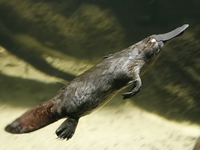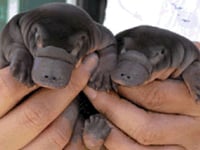

 |

|
 Duckbill Platypus |
Duckbill Platypus(Mammal) |
 Duckbill Platypus Baby |
Duckbill Platypus HabitsThe duckbill platypus always lives near water�mostly in the rivers of eastern Australia and Tasmania. It nests in tunnels that it digs in the
riverbanks or it lives in deep crevices and little caves in rocky banks. Its tunnels can run 50 feet long or more.
The platypus is amphibious (lives both on land and in water) and dives and swims well. It is a loner except during breeding season and is territorial, defending its own stretch of river from intruders.
The platypus uses its strong webbed front feet for both swimming and burrowing. When it walks on land it
curls its feet under its body to protect them. |
Duckbill Platypus CommunicationPlatypuses are Monotremes, the only mammals known to have a sense of electro reception (the ability to receive and make use of electrical impulses). Their electro reception is the most sensitive of any monotreme. The electro receptors of the Platypus are located in rostro-caudal rows in the skin of the bill.
The Platypus can determine the direction of an electric source, perhaps by comparing differences in signal strength across the sheet of electro receptors. This would explain the animal's characteristic side-to-side motion of its head while hunting.
The Platypus feeds by digging in the bottom of streams with its bill. The electro receptors could be used to distinguish live and dead objects in this situation. When disturbed, its prey would generate tiny electrical currents in their muscular contractions which the sensitive electro receptors of the Platypus could detect. Experiments have shown that the Platypus will even react to an 'artificial shrimp' if a small electrical current is passed through it. |
Duckbill Platypus BreedingThe male and female platypus
mate between August and
October. The pair court by
swimming around each other.
Then the female platypus
digs a long nesting tunnel in
the riverbank with a chamber
as its end. The nesting tunnel
is longer than the platypus's
home tunnel-it may be as
long as 65 feet.
The female collects grass and
leaves, grasps them under her
tail, and carries them back to
the tunnel to construct a nest.
There she lays two white, soft-
shelled eggs that she incu-
bates by holding them snugly
between her tail and belly.
Each egg is about the size of
a marble.
The hatching period is
variable. After one to two
cheek pouches are full, the
platypus surfaces and discards
any sand and stones it has
weeks the eggs hatch and
the young make their way
through their mother's fur
to suckle at her milk glands.
picked up, then grinds the
food between horny plates it
has instead of teeth.
The young stay in the
burrow up to five months
and continue to suckle after
they have left the burrow.
Above: Broad front feet make the
platypus a powerful underwater
swimmer, while smaller hind feet
provide agility. |
Duckbill Platypus Food & FeedingThe platypus hunts in the
water for prey such as insect
larvae, water snails, and small
crustaceans.
Underwater it closes its eyes,
ears, and nostrils and sweeps
its broad bill from side to side
to locate prey. The bill is soft
and pliable, not hard like a
duck's, and is highly sensitive.
The platypus swims along
using its front feet only. Most
of its dives last between 30
seconds and a minute and a
half. It sometimes remains
underwater by wedging it-
self beneath a log or under
a stone.
On the river bottom, the
platypus fills pouches in its
cheeks with food. When its
Left: The platypus's beak is the
ideal tool for feeding on the beds
of slow rivers and streams. |
Duckbill Platypus Key Facts |
| Size |
| Height: Length: male 1 1/2 to 2 feet. Female: Up to 1 1/2 feet |
| Weight: About 4 pounds |
| Breeding |
| Sexual maturity: 2 years |
| Mating: August to October |
| Gestation: 1-2 weeks |
| Number of young: Usually 2, sometimes 1 or 3 |
| Lifestyle |
| Habit: Solitary |
| Diet: Aquatic invertebrates |
| Lifespan: 10 years in the wild. 17 years in captivity |
DID YOU KNOW?
|
CAN'T FIND WHAT YOU'RE LOOKING FOR? CLICK HERE!!!